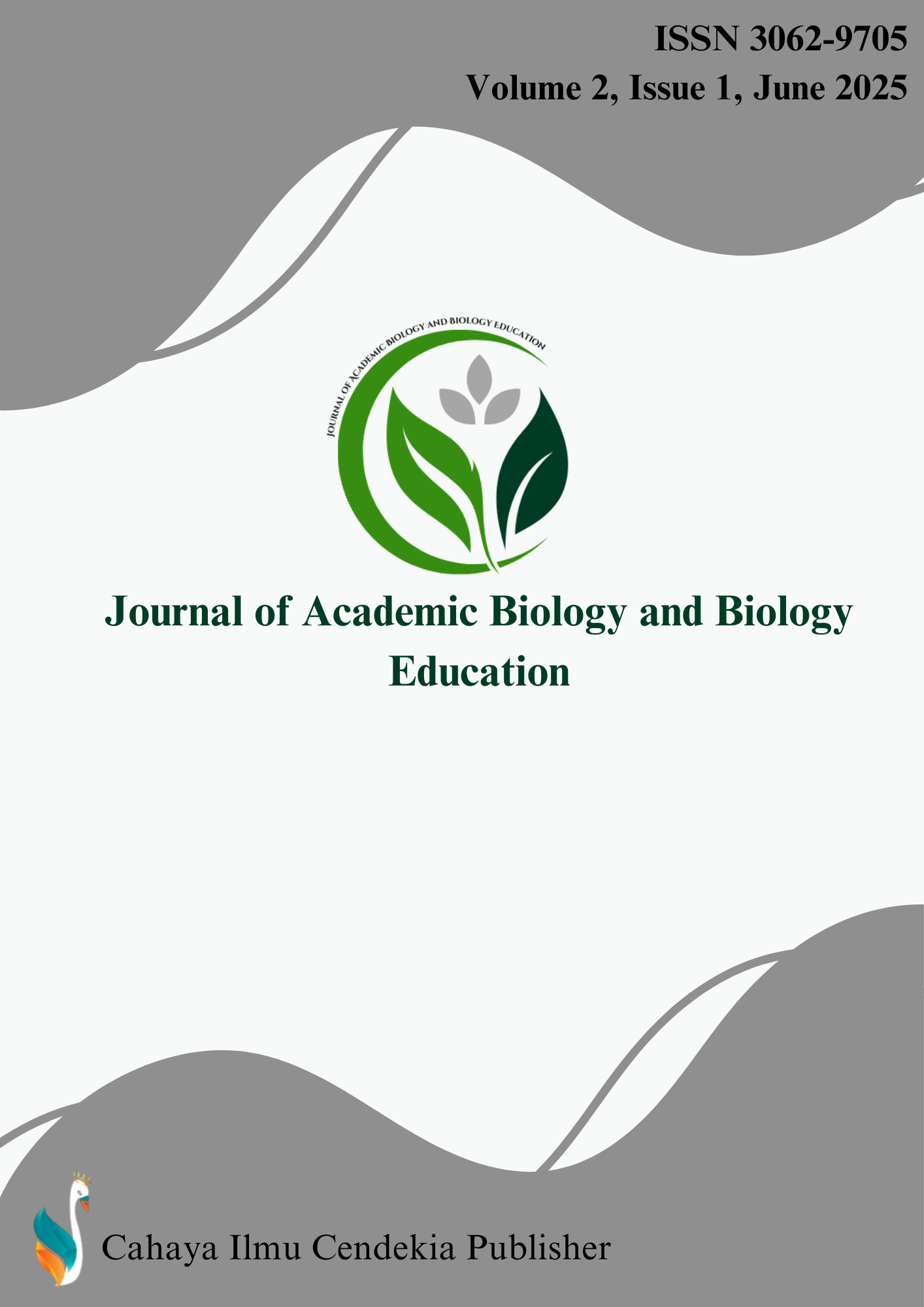Unexpected Insights: Raw Sub-Bituminous Coal Outperforms Gamma-Irradiated Coal in Bio-solubilization with Phanerochaete chrysosporium
Abstract
Purpose of the study: The purpose of this study is to investigate the effect of gamma irradiation treatment on sub-bituminous coal in the bio-solubilization process using Phanerochaete chrysosporium and to characterize the bio-solubilization products of raw and irradiated coal under laboratory conditions.
Methodology: This study used sub-bituminous coal from South Sumatra, gamma irradiated with an Irpasena irradiator, and biosolubilized with Phanerochaete chrysosporium. Instruments included a Precision® shaker incubator, Novel® microscope, Hanna® pH meter, Shimadzu® GC-MS, and Shimadzu® UV-Vis spectrophotometer. Data were analyzed statistically using T-test with SPSS version 20 software.
Main Findings: The results revealed that raw coal exhibited higher solubilization efficiency compared to irradiated coal, indicated by a greater increase in soluble phenolic (0.95 mg/mL) and aromatic compounds (1.42 mg/mL), as well as higher protein production. GC-MS analysis confirmed that raw coal generated more diverse and abundant metabolites, including phenolic and aromatic derivatives, while irradiated coal produced fewer compounds. Statistical analysis (T-test, p < 0.05) supported the significant differences between treatments. These findings suggest that gamma irradiation does not enhance, and may even inhibit, coal bio-solubilization ..
Novelty/Originality of this study: This study provides new evidence that gamma irradiation does not enhance, but rather reduces, the bio-solubilization efficiency of sub-bituminous coal by Phanerochaete chrysosporium. The findings challenge the common assumption about irradiation benefits and contribute to advancing knowledge by highlighting the superior performance of raw coal in producing energy-equivalent products.
References
L. D. Hersaputri et al., “Reducing fossil fuel dependence and exploring just energy transition pathways in Indonesia using OSeMOSYS (open-source energy modelling system),” Climate, vol. 12, no. 3, p. 37, Mar. 2024, doi: 10.3390/cli12030037.
M. Ichsan, M. Lockwood, and M. Ramadhani, “National oil companies and fossil fuel subsidy regimes in transition: The case of Indonesia,” Extr. Ind. Soc., vol. 11, p. 101104, 2022, doi: 10.1016/j.exis.2022.101104.
I. W. Ngarayana, J. Sutanto, and K. Murakami, “Predicting the future of Indonesia: energy, economic and sustainable environment development,” IOP Conf. Ser. Earth Environ. Sci., vol. 753, no. 1, 2021, doi: 10.1088/1755-1315/753/1/012038.
T. Anas, H. Hill, D. Narjoko, and C. T. Putra, “The Indonesian economy in turbulent times,” Bull. Indones. Econ. Stud., vol. 58, no. 3, pp. 241–271, 2022, doi: 10.1080/00074918.2022.2133344.
D. Khatiwada, C. Palmén, and S. Silveira, “Evaluating the palm oil demand in Indonesia: production trends, yields, and emerging issues,” Biofuels, vol. 12, no. 2, pp. 135–147, 2021, doi: 10.1080/17597269.2018.1461520.
A. D. A. Bin Abu Sofian, H. R. Lim, H. Siti Halimatul Munawaroh, Z. Ma, K. W. Chew, and P. L. Show, “Machine learning and the renewable energy revolution: Exploring solar and wind energy solutions for a sustainable future including innovations in energy storage,” Sustain. Dev., vol. 32, no. 4, pp. 3953–3978, 2024, doi: 10.1002/sd.2885.
M. J. B. Kabeyi and O. A. Olanrewaju, “Sustainable energy transition for renewable and low carbon grid electricity generation and supply,” Front. Energy Res., vol. 9, no. March, pp. 1–45, 2022, doi: 10.3389/fenrg.2021.743114.
N. S. Akimbekov, I. Digel, K. T. Tastambek, A. K. Marat, M. A. Turaliyeva, and G. K. Kaiyrmanova, “Biotechnology of microorganisms from coal environments: from environmental remediation to energy production,” Biology (Basel)., vol. 11, no. 9, 2022, doi: 10.3390/biology11091306.
J. Gasparotto and K. Da Boit Martinello, “Coal as an energy source and its impacts on human health,” Energy Geosci., vol. 2, no. 2, pp. 113–120, 2021, doi:10.1016/j.engeos.2020.07.003.
G. F. Smaisim, A. M. Abed, and H. Alavi, “Analysis of pollutant emission reduction in a coal power plant using renewable energy,” Int. J. Low-Carbon Technol., vol. 18, pp. 38–48, Feb. 2023, doi: 10.1093/ijlct/ctac130.
L. O. Zahara P., C. S. Permatasari, I. Supriyadi, and A. Andreyani, “The coal bio-solubilization technology for energy security,” Indones. J. Energy, vol. 4, no. 1, pp. 1–12, 2021, doi: 10.33116/ije.v4i1.101.
Q. Li, “The view of technological innovation in coal industry under the vision of carbon neutralization,” Int. J. Coal Sci. Technol., vol. 8, no. 6, pp. 1197–1207, 2021, doi: 10.1007/s40789-021-00458-w.
W. J. Liu and H. Q. Yu, “Thermochemical conversion of lignocellulosic biomass into mass-producible fuels: emerging technology progress and environmental Sustainability Evaluation,” ACS Environ. Au, vol. 2, no. 2, pp. 98–114, 2022, doi: 10.1021/acsenvironau.1c00025.
T. A. Schueler, M. L. Dourado, S. S. Videira, C. D. da Cunha, and A. C. L. Rizzo, “Biosolubilization of verdete: an alternative potassium source for agriculture fertilizer,” Biocatal. Agric. Biotechnol., vol. 34, p. 102031, 2021, doi: 10.1016/j.bcab.2021.102031.
H. Kang et al., “Bacteria solubilization of shenmu lignite: influence of surfactants and characterization of the biosolubilization products,” Energy Sources, Part A Recover. Util. Environ. Eff., vol. 43, no. 10, pp. 1162–1180, May 2021, doi: 10.1080/15567036.2019.1635664.
L. M. Sekhohola-Dlamini, S. Khan, B. Wang, Z. Yu, and A. K. Cowan, “Recent progress on the biological degradation and solubilization of coal,” Biodegradation, vol. 36, no. 5, p. 84, 2025, doi: 10.1007/s10532-025-10175-9.
L. Zhang, Z. Zhang, R. Yang, G. Zhang, and Y. Wang, “Bio-solubilization of Yunnan lignite by Penicillium ortum MJ51 and characterization of its products,” Fuel, no. 211, pp. 1–8, 2025, doi: 10.1016/j.fuel.2022.125923.
C. Koyunoğlu and H. Karaca, “Microbial desulphurisation of coal: a review,” Int. J. Sustain. Energy, vol. 42, no. 1, pp. 1–24, 2023, doi: 10.1080/14786451.2023.2167998.
Y. Qiu, Y. Liu, L. Yang, Z. Yang, Z. Wang, and C. Wei, “Construction of immobilized functional microflora system and research on mechanism of enhanced degradation of aromatic compounds in coal chemical wastewater,” Water Res., vol. 283, p. 123876, 2025, doi: 10.1016/j.watres.2025.123876.
Y. Li et al., “Promotion effect and mechanism analysis of different strain pre-treatment on methane conversion from lignite,” Processes, vol. 13, no. 8, pp. 1–11, 2025, doi: 10.3390/pr13082581.
L. C. Ram, P. S. M. Tripathi, S. K. Jha, K. P. Sharma, G. Singh, and S. P. Mishra, “γ-irradiation of coal and lignite: effect on extractability,” Fuel Process. Technol., vol. 53, no. 1, pp. 1–14, 1997, doi: 10.1016/S0378-3820(96)01083-1.
I. Sugoro, S. Hermanto, D. Sasongko, D. Indriani, and P. Aditiawati, “Karakterisasi produk biosolubilisasi lignit oleh kapang indigenus dari tanah pertambangan batubara di Sumatera Selatan [Characterization of lignite biosolubilization products by indigenous fungi from coal mining soil in South Sumatra],” J. Biol. Indones., vol. 7, no. 2, pp. 299–308, 2011, [Online]. Available: https://e-journal.biologi.lipi.go.id/index.php/jurnal_biologi_indonesia/article/view/3116
S. Shahi, R. Khorvash, M. Goli, S. M. Ranjbaran, A. Najarian, and A. Mohammadi Nafchi, “Review of proposed different irradiation methods to inactivate food‐processing viruses and microorganisms,” Food Sci. Nutr., vol. 9, no. 10, pp. 5883–5896, Oct. 2021, doi: 10.1002/fsn3.2539.
P. Sharma, A. P. Venugopal, P. P. Sutar, H. Xiao, and Q. Zhang, “Mechanism of microbial spore inactivation through electromagnetic radiations: a review,” J. Futur. Foods, vol. 4, no. 4, pp. 324–334, 2024, doi: 10.1016/j.jfutfo.2023.11.004.
I. Sugoro, D. I. Astuti, D. Sasongko, and P. Aditiawati, “Comparison of gamma irradiated and raw lignite in bioliquefaction process by fungus T5,” Atom Indones., vol. 38, no. 2, pp. 51–56, 2012, doi: 10.17146/aij.2012.160.
H. K. Mustafa, S. S. Anwer, and T. J. Zrary, “Influence of pH, agitation speed, and temperature on growth of fungi isolated from Koya, Iraq,” Kuwait J. Sci., vol. 50, no. 4, pp. 657–664, 2023, doi: 10.1016/j.kjs.2023.02.036.
W. Sui et al., “Potential hydrothermal-humification of vegetable wastes by steam explosion and structural characteristics of humified fractions,” Molecules, vol. 26, no. 13, 2021, doi: 10.3390/molecules26133841.
A. T. Naikwadi, B. K. Sharma, K. D. Bhatt, and P. A. Mahanwar, “Gamma radiation processed polymeric materials for high performance applications: a review,” Front. Chem., vol. 10, no. March, pp. 1–15, 2022, doi: 10.3389/fchem.2022.837111.
G. Yu, D. Jin, F. Zhang, S. Tian, Z. Zhou, and Z. Ren, “Extraction-adsorption coupled desulfurization of fuel oil by novel functionalized porous liquids,” Chem. Eng. J., vol. 453, p. 139935, 2023, doi: 10.1016/j.cej.2022.139935.
H. Zhang, L. Chen, Y. Chen, and Z. Wang, “Removal of sulfide from fuels by ionic liquids: prospects for the future,” Brazilian J. Chem. Eng., vol. 40, no. 4, pp. 929–963, 2023, doi: 10.1007/s43153-023-00304-3.
M. Abdallah et al., “Evaluation of porphyrin molecules as effective corrosion inhibitors for copper alloy in sulfuric acid using both experimental and computational approaches,” J. Electrochem. Sci. Eng., vol. 15, no. 2, pp. 1–26, 2025, doi: 10.5599/jese.2544.
N. EL Hasbaoui, A. EL Hadrami, K. Essifi, J. Assaoui, and R. Brahmi, “Recycling of spent catalysts used in sulfuric acid production,” Moroccan J. Chem., vol. 13, no. 1, pp. 405–423, 2025, doi: 10.48317/IMIST.PRSM/morjchem-v13i1.51501.
R. Kumari, A. Singh, and A. N. Yadav, “Fungal Enzymes: Degradation and Detoxification of Organic and Inorganic Pollutants BT - Recent Trends in Mycological Research: Volume 2: Environmental and Industrial Perspective,” A. N. Yadav, Ed., Cham: Springer International Publishing, 2021, pp. 99–125. doi: 10.1007/978-3-030-68260-6_5.
S. M. McNichol, F. Sanchez-Quete, S. K. Loeb, A. P. Teske, S. R. Shah Walter, and N. Mahmoudi, “Dynamics of carbon substrate competition among heterotrophic microorganisms,” ISME J., vol. 18, no. 1, 2024, doi: 10.1093/ismejo/wrae018.
Y. Xu et al., “Characteristics and correlation of the microbial communities and flavor compounds during the first three rounds of fermentation in Chinese sauce-flavor Baijiu,” Foods, vol. 12, no. 1, 2023, doi: 10.3390/foods12010207.
X. H. Zhang, W. Ahmad, X. Y. Zhu, J. Chen, and B. Austin, “Viable but nonculturable bacteria and their resuscitation: implications for cultivating uncultured marine microorganisms,” Mar. Life Sci. Technol., vol. 3, no. 2, pp. 189–203, 2021, doi: 10.1007/s42995-020-00041-3.
R. C. Prins and S. Billerbeck, “A buffered media system for yeast batch culture growth,” BMC Microbiol., vol. 21, no. 1, pp. 1–9, 2021, doi: 10.1186/s12866-021-02191-5.
A. B. E.-D. Abd El-Aziz, M. El-Mokadem, H. H. Abo-Ghalia, Z. A. Mattar, and A. I. Sallam, “Biosynthesis of a novel composite resin incorporating gamma radiation synthesized pomegranate extract–coated zinc oxide nanoparticles and in vitro assessment against streptococcus mutans causing dental caries,” Bionanoscience, vol. 14, no. 5, pp. 5017–5034, 2024, doi: 10.1007/s12668-024-01410-3.
M. A. Mosleh, G. S. El-Sayyad, M. A. Gobara, Y. A. Hasanien, E. H. El-Hakim, and E. H. Borai, “Synthesis, characterization, and gamma-irradiation of silica nanoparticles from white sand and their application as a hydrophobic antibacterial material,” Bionanoscience, vol. 15, no. 2, p. 289, 2025, doi: 10.1007/s12668-025-01880-z.
K. Y. Shi et al., “Quantitative measurement of coal bio-solubilization by ultraviolet-visible spectroscopy,” Energy Sources, Part A Recover. Util. Environ. Eff., vol. 35, no. 15, pp. 1456–1462, 2013, doi: 10.1080/15567036.2010.521800.
N. Akimbekov, I. Digel, G. Abdieva, P. Ualieva, and K. Tastambek, “Lignite biosolubilization and bioconversion by Bacillus sp.: the collation of analytical data,” Biofuels, vol. 12, no. 3, pp. 247–258, Mar. 2021, doi: 10.1080/17597269.2020.1753936.
J. Sobolczyk-Bednarek, A. Choińska-Pulit, and W. Łaba, “Biosolubilization of low-rank coal by the newly isolated strain Streptomyces fulvissimus K59,” Fuel, vol. 301, p. 121082, 2021, doi: 10.1016/j.fuel.2021.121082.
K. Bhandari et al., “A comparative investigation of ultrasonication and magnetic stirring methods for green synthesis of zinc oxide nanoparticles using Punica granatum peels,” Sci. Rep., vol. 15, no. 1, pp. 1–11, 2025, doi: 10.1038/s41598-025-04926-0.
A. Grzyb, A. Wolna-Maruwka, and A. Niewiadomska, “The significance of microbial transformation of nitrogen compounds in the light of integrated crop management,” Agronomy, vol. 11, no. 7, p. 1415, Jul. 2021, doi: 10.3390/agronomy11071415.
S. Vitale et al., “Nitrogen source orchestrates pH modulation and secondary metabolism in Trichoderma harzianum,” Chem. Biol. Technol. Agric., vol. 12, no. 1, 2025, doi: 10.1186/s40538-025-00735-9.
C. Zhang, M. Li, S. Zhang, Z. Qi, J. Huang, and J. Sun, “An improved method of fluorescein diacetate determination for assessing the effects of pollutants on microbial activity in urban river sediments,” J. Soils Sediments, vol. 22, no. 10, pp. 2792–2801, 2022, doi: 10.1007/s11368-022-03319-4.
Z. Zhang et al., “Evaluation methods of inhibition to microorganisms in biotreatment processes: a review,” Water Cycle, vol. 4, pp. 70–78, 2023, doi: 10.1016/j.watcyc.2023.02.004.
W. Janati, B. Benmrid, W. Elhaissoufi, Y. Zeroual, J. Nasielski, and A. Bargaz, “Will phosphate bio-solubilization stimulate biological nitrogen fixation in grain legumes?,” Front. Agron., vol. 3, no. March, 2021, doi: 10.3389/fagro.2021.637196.
Y. Titilawo, W. L. Masudi, J. T. Olawale, L. M. Sekhohola-Dlamini, and A. K. Cowan, “Coal-degrading bacteria display characteristics typical of plant growth promoting rhizobacteria,” Processes, vol. 8, no. 9, 2020, doi: 10.3390/pr8091111.
M. Z. ur Rehman et al., “Bioconversion and quantification of humic substances from low rank coals using indigenous fungal isolates,” J. Clean. Prod., vol. 376, pp. 1–34, 2022, doi: 10.1016/j.jclepro.2022.134102.
A. Gałązka, U. Jankiewicz, and S. Orzechowski, “The role of ligninolytic enzymes in sustainable agriculture: applications and challenges,” Agronomy, vol. 15, no. 2, p. 451, Feb. 2025, doi: 10.3390/agronomy15020451.
K. Shi, Y. Liu, P. Chen, and Y. Li, “Contribution of lignin peroxidase, manganese peroxidase, and laccase in lignite degradation by mixed white-rot fungi,” Waste and Biomass Valorization, vol. 12, no. 7, pp. 3753–3763, 2021, doi: 10.1007/s12649-020-01275-z.
Copyright (c) 2025 Arina Findo Sari, Zharifa G. Rasul, Jamela B. Sampulna

This work is licensed under a Creative Commons Attribution 4.0 International License.
Authors who publish with this journal agree to the following terms:
- Authors retain copyright and acknowledge that the Journal of Academic Biology and Biology Education is the first publisher licensed under a Creative Commons Attribution 4.0 International License.
- Authors are able to enter into separate, additional contractual arrangements for the non-exclusive distribution of the journal's published version of the work (e.g., post it to an institutional repository or publish it in a book), with an acknowledgment of its initial publication in this journal.
- Authors are permitted and encouraged to post their work online (e.g., in institutional repositories or on their website) prior to and during the submission process, as it can lead to productive exchanges and earlier and greater citation of published work.



.png)

.png)
.png)








